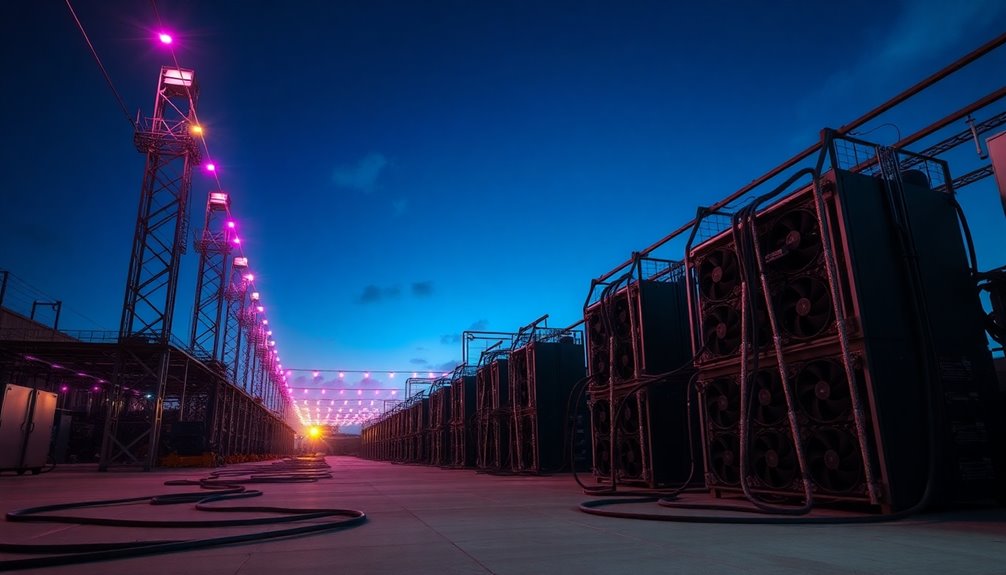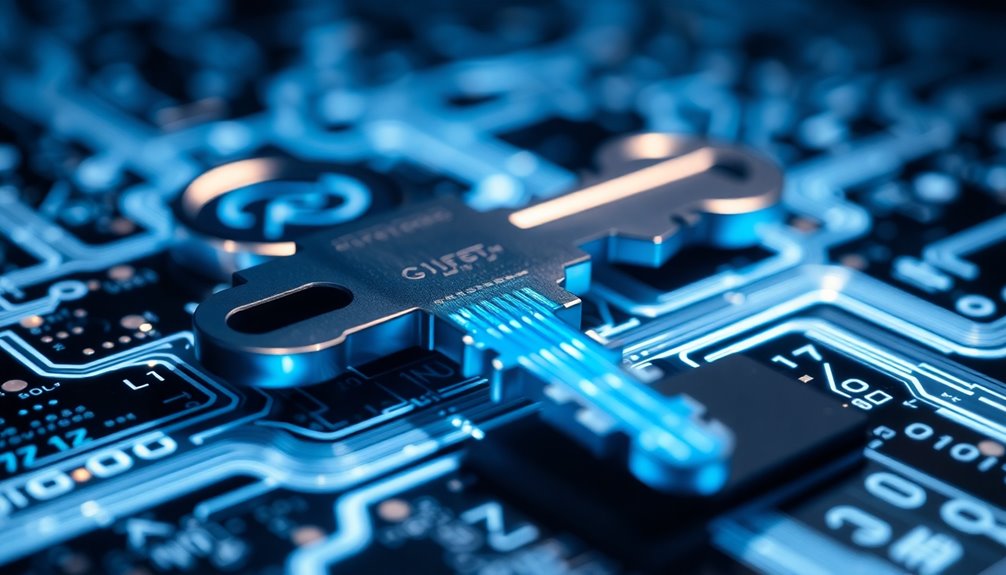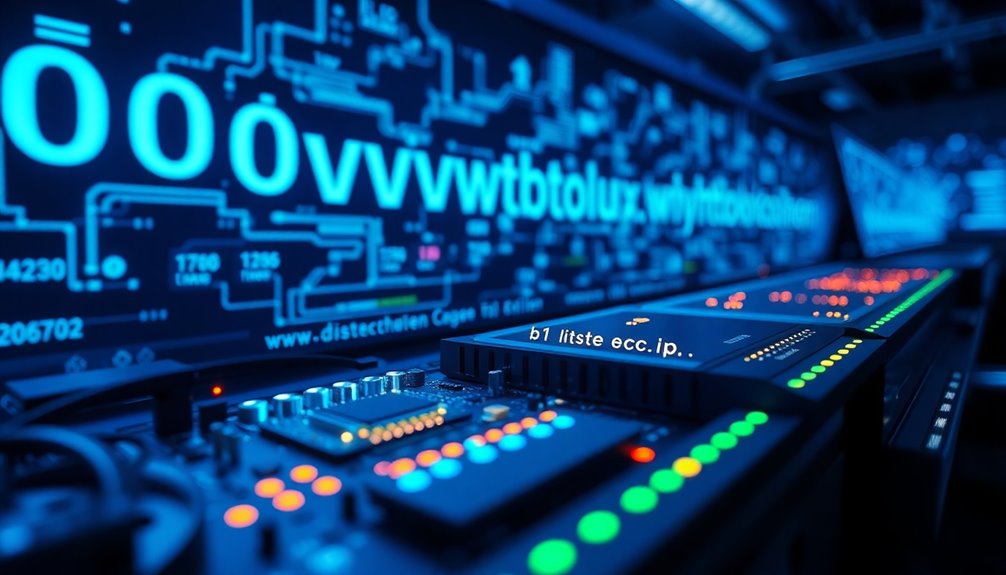Rig mining is the process where you use specialized hardware to solve cryptographic puzzles, securing blockchain networks while generating cryptocurrencies. You can choose from different types of rigs, like CPU, GPU, FPGA, or ASIC, each with unique performance levels. A typical rig setup includes a motherboard, multiple GPUs or ASICs, a power supply, and a cooling system. Investing in high-efficiency components can significantly enhance your mining success. However, it's essential to consider costs related to energy, maintenance, and space. If you're curious about optimizing your mining operations and enhancing profitability, you'll want to keep exploring more options.
Key Takeaways
- Rig mining involves using specialized hardware to solve cryptographic puzzles for earning cryptocurrencies.
- Common hardware types include CPU, GPU, FPGA, and ASIC, each with unique performance characteristics.
- A typical mining rig setup includes a motherboard, multiple GPUs or ASICs, power supply, and cooling system.
- Cooling methods range from air cooling to liquid and immersion cooling, impacting performance and longevity.
- Profitability is influenced by setup costs, energy efficiency, and market fluctuations in cryptocurrency values.
Mining Hardware Essentials

When diving into rig mining, understanding the essentials of mining hardware is key to your success.
You'll want to invest in top-tier GPUs like the Nvidia GeForce RTX 3080 or AMD Radeon RX 6800 XT, as they significantly impact your rig's performance. Using multiple GPUs, around four to six, can boost your hash rates, allowing for more efficient mining. Additionally, be aware that profitability varies based on the cryptocurrency you choose to mine.
Alternatively, consider ASICs, specialized machines like the Bitmain Antminer S19 Pro, which offer higher hash rates but are limited to specific algorithms.
Don't forget about your CPU and motherboard; even a moderate CPU can suffice for GPU mining, but ensure your motherboard supports multiple GPUs.
Lastly, a robust power supply and effective cooling are crucial for a stable rig.
Overview of Rig Mining
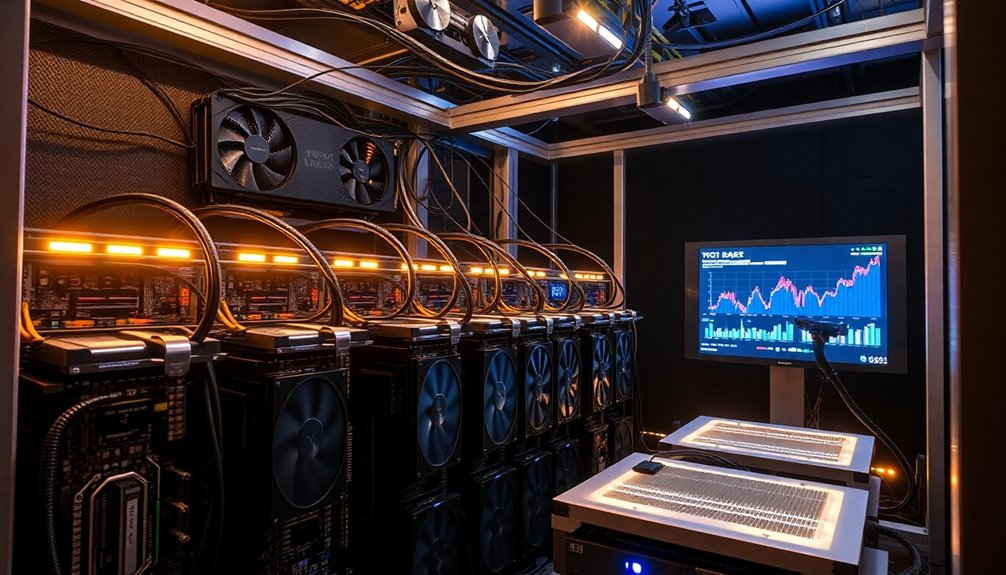
Rig mining is an innovative approach to cryptocurrency mining that harnesses specialized hardware to solve complex cryptographic puzzles. A mining rig is essentially a computer system designed specifically for this purpose, processing transactions and securing networks using a Proof-of-Work algorithm.
You can choose from various types of rigs, including CPU, GPU, FPGA, or ASIC, each offering different performance levels and efficiencies. Your rig's setup typically includes a motherboard, multiple GPUs or ASICs, a power supply, and a cooling system. ASIC miners are particularly known for their high efficiency and optimization for specific cryptocurrencies.
As you plan your mining venture, consider factors like electricity costs, space, and the specific cryptocurrency you want to mine. Regular maintenance and upgrades are essential to keep your rig efficient and profitable over time.
Mining Process Explained Simply
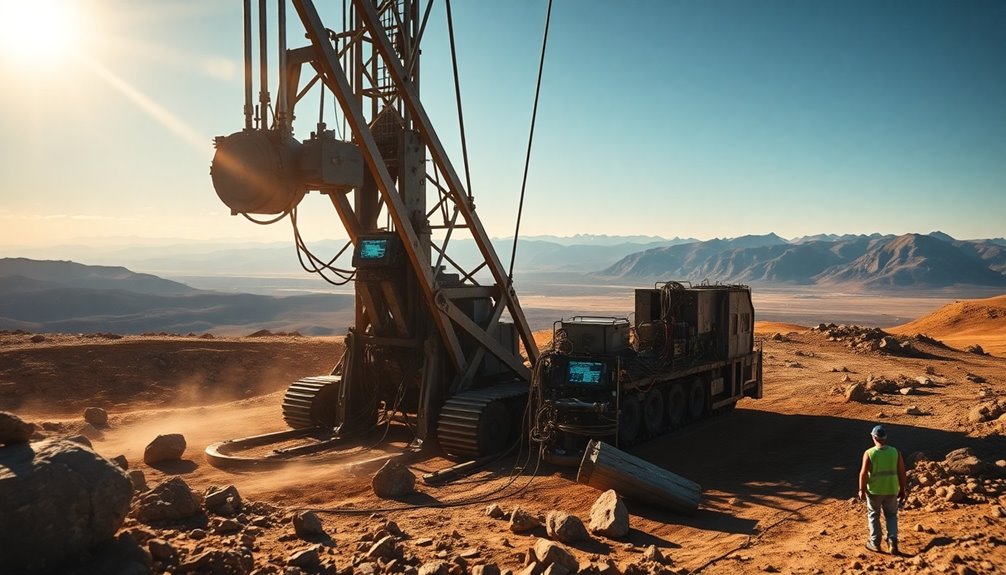
Understanding the mining process can seem daunting, but breaking it down into manageable steps makes it easier to grasp.
First, geologists explore the terrain to identify mineral reserves using mapping, measurements, and drilling for core samples. Once data's collected, a resource model distinguishes between ore and waste rock.
Next, extraction begins—either through open-pit mining with drilling and blasting or subsurface methods by developing tunnels. This phase is crucial as low unit costs are essential for the economic viability of mining operations.
The extracted ore goes to a processing facility, where it's crushed, mixed with water, and further refined to extract minerals.
Finally, the refined minerals are shipped to customers, while the mining area is restored to its natural state, ensuring environmental considerations are met throughout the entire process.
Pros and Cons
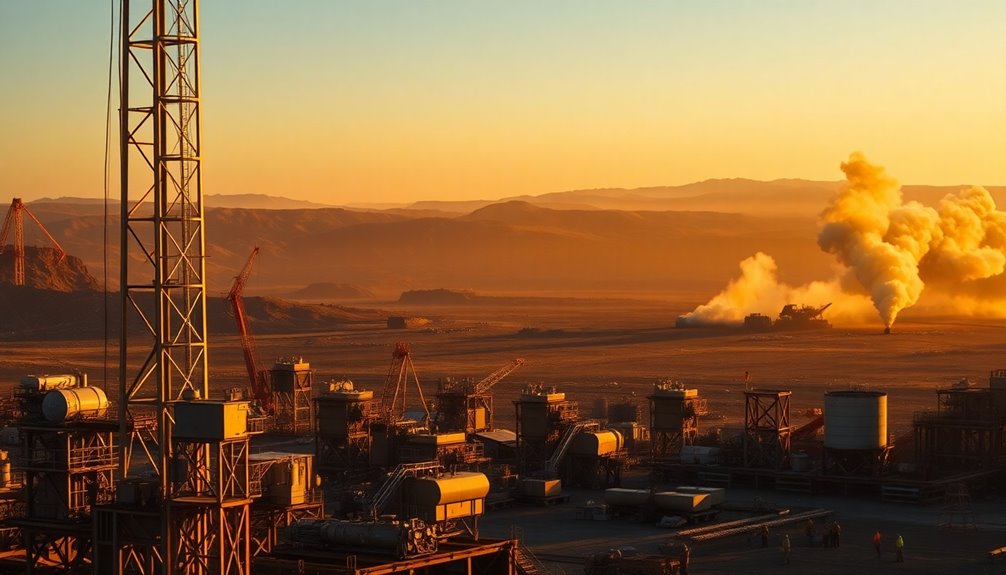
While there are significant financial rewards to be gained from rig mining, it's essential to weigh these against the potential drawbacks.
On the upside, you can earn newly created cryptocurrencies and potentially offset heating costs, leading to lucrative income. The flexibility of moving rigs and using cloud services adds convenience. Additionally, Bitcoin mining involves validating transactions and adding them to the blockchain, which can be a fascinating aspect of the process. Mining operations are often influenced by mining difficulty adjustments, which can affect overall profitability.
However, be mindful of the high initial setup and maintenance costs, as well as the ongoing need for technical expertise. Energy consumption can spike, leading to substantial electricity bills and environmental concerns.
Additionally, hardware reliability issues may disrupt your operations, and market fluctuations can affect profitability.
Balancing these pros and cons will help you make informed decisions in your rig mining journey.
Cost vs. Performance Analysis
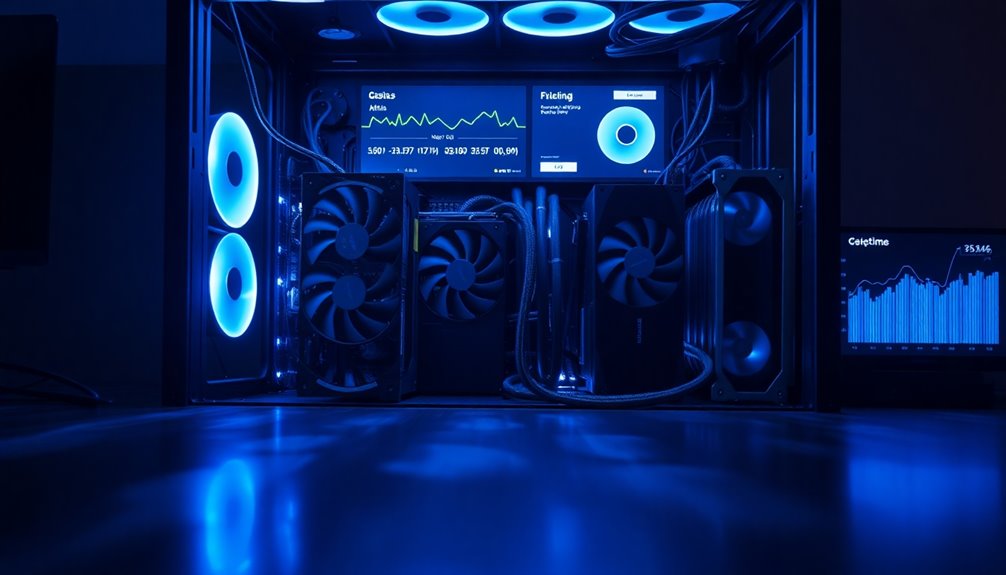
When evaluating the cost versus performance in rig mining, it's crucial to balance your initial investment with potential returns. High-performance ASIC miners, like the Antminer S19 XP costing around $9,500, weigh heavily on your budget.
Alternatively, building a home mining rig can set you back about $3,400. Energy efficiency matters too; newer miners consume significantly less power per terahash, enhancing profitability. For instance, the Antminer S21 has a hash rate of 335 TH/s. Optimizing hash rates helps in maximizing mining efficiency, making it essential for miners to focus on performance metrics.
Monitoring these performance metrics helps you optimize operations and spot issues early. Ultimately, you'll need to consider both upfront costs and ongoing electricity expenses to ensure your mining venture remains profitable in the long run.
Market Volatility Impacts Profitability
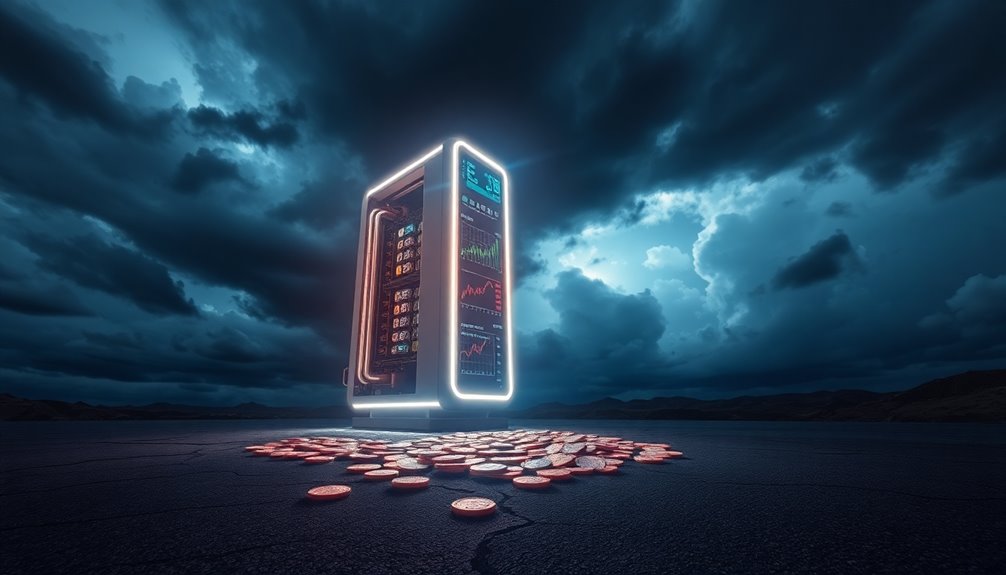
Market volatility plays a crucial role in determining your profitability in rig mining, as fluctuations in Bitcoin prices can significantly impact your revenue.
When the market's hot, your earnings can soar, sometimes multiplying several times thanks to higher Bitcoin prices. However, increased competition from new miners can lower the amount of Bitcoin you earn.
Conversely, during bear markets, your revenues drop, making it tougher to cover costs, including your rig's electricity usage. To enhance your profitability, understanding mining profitability determinants is essential, as it includes factors like hardware efficiency and electricity prices.
To stay profitable, you'll need to manage your energy expenses carefully. Lower rates are essential, especially when Bitcoin prices fall.
Adapting to these market dynamics is key; successful miners find ways to thrive, even as conditions shift dramatically.
Emergence of Eco-Friendly Mining
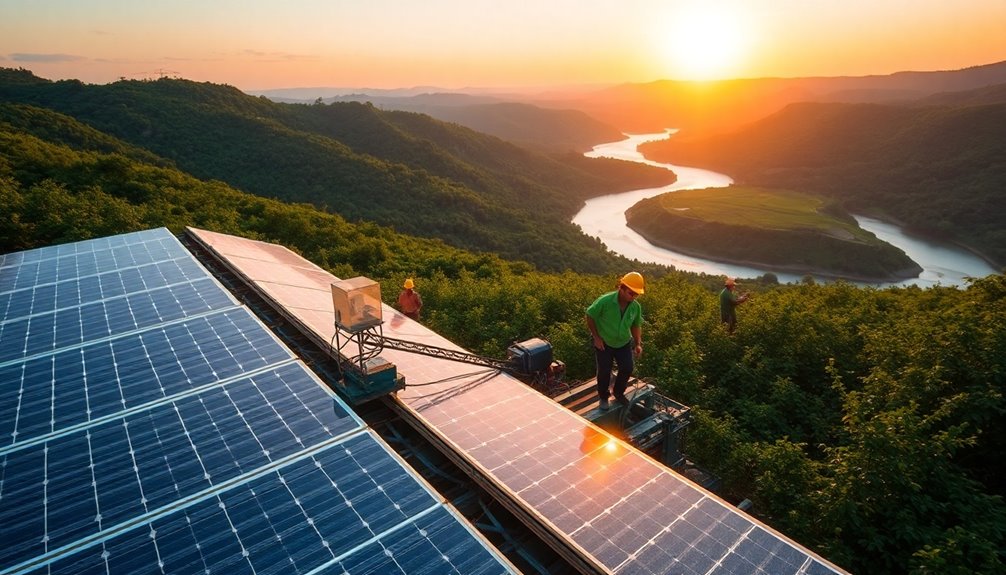
As rig mining faces the challenges of market volatility, miners are increasingly turning to eco-friendly practices to sustain their operations and enhance profitability.
You can adopt lower-impact mining techniques like in-situ leaching and bioleaching, which minimize soil disturbance and waste generation. Sustainable mining techniques help to reduce the volume of material requiring backfilling, further enhancing environmental protection.
Using electric vehicles and renewable energy sources not only cuts down on carbon emissions but also showcases your commitment to sustainability.
Reusing mining waste through up-cycling or further mineral extraction from tailings contributes to a circular economy, reducing your environmental footprint.
By prioritizing water conservation and habitat restoration, you ensure that ecosystems are preserved for future generations.
Embracing these eco-friendly methods can improve your operational efficiency and bolster your reputation in a competitive market.
Optimal Cooling Solutions
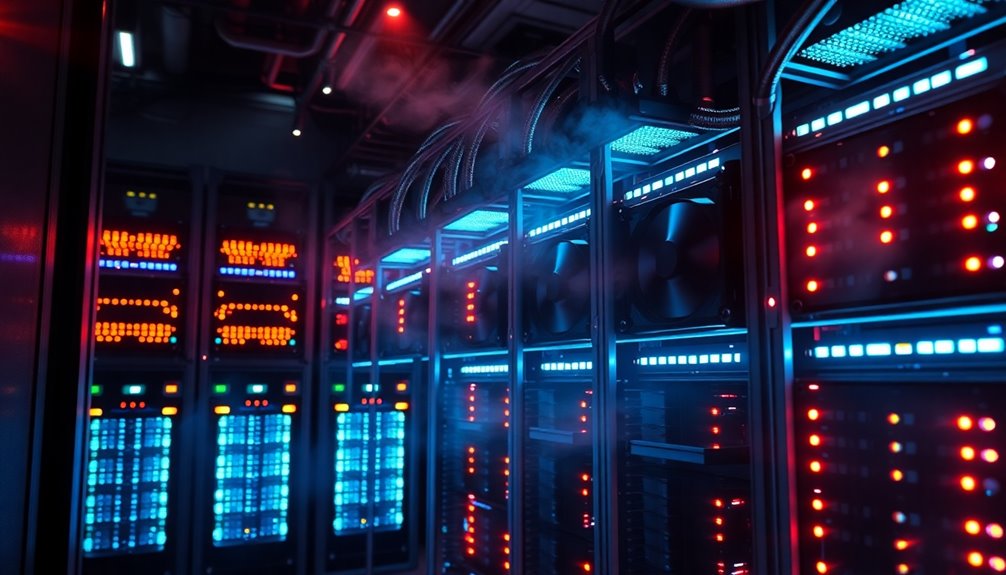
Finding the right cooling solution for your mining rig is essential to maintaining its performance and longevity. Air cooling is affordable and easy to set up, making it great for small-scale operations. It relies on fans and ventilation, but you need a well-ventilated space to work effectively. On the other hand, liquid cooling offers superior heat management for high-performance rigs, though it's more complex and costly. If you're looking for efficiency, consider immersion cooling, which submerges hardware in a dielectric fluid to absorb heat. Effective cooling systems are vital to prolonging the lifespan of expensive mining equipment. Each option has its benefits, so assess your equipment and needs carefully.
Frequently Asked Questions
How Long Does It Take to Set up a Mining Rig?
Setting up a mining rig typically takes anywhere from a few hours to a full day, depending on your experience and the complexity of the rig.
If you're organized and have all your components ready, you can complete the assembly in a few hours.
However, troubleshooting and configuring the software might take additional time.
Don't rush it; ensure everything's correctly installed and connected for optimal performance and stability.
What Are the Best Cryptocurrencies to Mine Currently?
So, you wanna dive into the glamorous world of crypto mining, huh?
Well, if you're not ready to break the bank, consider Monero or Ravencoin for their accessibility.
If you've got the cash, Bitcoin and Litecoin shine bright, but don't forget those costly ASICs!
Ethereum Classic offers a decent middle ground, too.
Just remember, keep an eye on electricity costs—because who doesn't love a surprise bill, right?
Happy mining!
Can I Mine Using a Laptop or Gaming PC?
Yes, you can mine using either a laptop or a gaming PC.
Laptops are more suited for beginners and mining altcoins, but they're generally less profitable than dedicated setups.
A gaming PC, with its powerful GPU, handles the intense computational tasks better and offers higher profitability.
Just ensure you have the right hardware, efficient cooling, and stable power supply to maximize your mining experience.
What Legal Regulations Should I Consider for Mining?
Before you dive into the world of mining, think of it like navigating a dense forest; you'll need to know the paths and pitfalls.
You've got to consider federal laws like NEPA and CERCLA, as well as state and local regulations that vary widely.
Don't forget about tax implications, too; the IRS sees your mining profits as self-employment income.
Stay informed, so you can keep your venture compliant and thriving amidst the regulatory thicket.
How Do I Join a Mining Pool Effectively?
To join a mining pool effectively, start by researching pools with solid reputations and fair reward distributions.
Evaluate their size and hashrate, balancing the benefits of larger pools against potential centralization.
After selecting a pool, ensure your hardware is compatible and optimize your mining software.
Connect to the pool using the stratum address and set up your wallet for rewards.
Finally, regularly monitor performance to maximize your mining efficiency.
Conclusion
In the world of rig mining, you've explored the hardware essentials, simplified the mining process, and weighed the pros and cons. You've seen how market volatility can impact profitability and discovered the rise of eco-friendly solutions. By embracing optimal cooling techniques, you can enhance your mining efficiency. So, whether you're diving into the rig mining arena for profit or passion, remember: knowledge is power, and the right tools make all the difference in your journey.
